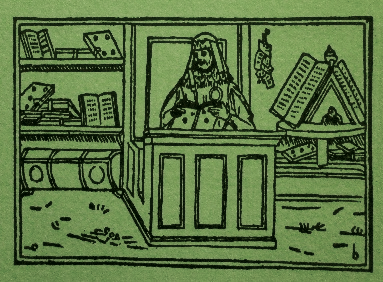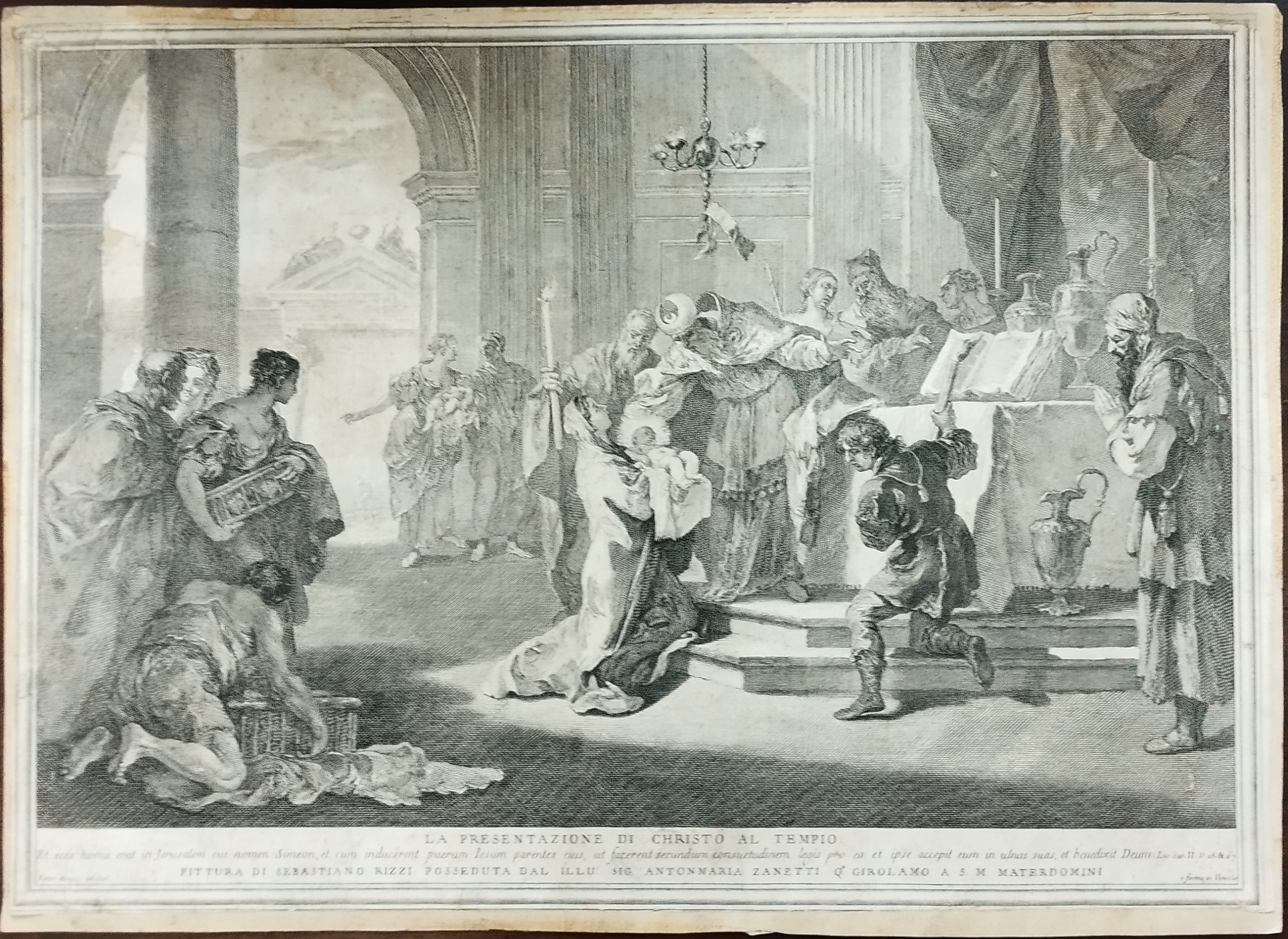Incisione su rame all’acquaforte e bulino di 502 x 360 mm., applicata su cartoncino ottocentesco. II stato su V. Alcuni difetti e qualche piccola mancanza. Al centro in basso: “La presentazione di Christo al Tempio. Et ecce homo erat inJerusalem cui nomen Simeon, et cura inducerent puerum Iesum parentes eus, ut facereat secundum consuetudinem legis pro eo et ipse accepit eum in ulnas suas, et benedixit Deum. Luc. Cap. II v. 25 & a 7. Pittura di Sebastiano Rizzi posseduta dal illu Antonmaria Zanetti Q. Girolamo A. & M. Materdomini.”. In piccolo a sinistra “Pietro Monaco scul et del”; a destra “e forma in Venezia”. La complessa vicenda di riedizioni della “Raccolta di cinquanta cinque storie sacre incise in altrettanti rami…” è segnata da varie tappe editoriali e di modifica nello stato dei rami, a partire dalla prima pubblicazione a Venezia, avvenuta in fascicoli dal 1739 e in volumi dal 1743 (per la storia dettagliata della serie, delle diverse ristampe e degli stati delle matrici si veda Apolloni 2000 e Apolloni in Donvito, Ton 2012, pp. 361-362, 376-379). La serie venne portata nel tempo fino a 112 soggetti, di cui sono stati individuati a livello indicativo cinque stati diversi, corrispondenti rispettivamente a un primo stato delle lastre mantenutosi fino all’edizione veneziana di Guglielmo Zerletti del 1763, dal titolo “Raccolta di cento dodici stampe di pitture della storia sacra incise per la prima volta in rame fedelmente copiata dagli originali di celebri autori antichi”, a un secondo stato con aggiunta di una sequenza delle tavole in numeri arabi nell’edizione curata da Alessandri e Scattaglia nel 1772 (dal titolo “Raccolta di cento e dodeci quadri rappresentanti istorie sacre dipinti da’ più celebri, e rinomati pittori…”), a un terzo stato recante l’indirizzo di Teodoro Viero nell’edizione del 1789, a un quarto stato con indirizzo milanese dei fratelli Pietro e Giuseppe Vallardi nell’edizione ottocentesca (forse tra il 1819 e il 1822), per arrivare al quinto e ultimo stato noto, in cui viene abrasa l’indicazione di edizione dei Vallardi. Anche per la cornice decorativa, ricavata su matrice separata da disegno di Giambattista Crosato, risultano noti quattro diversi stati. Molte stampe, infatti, sono ricavate con due matrici, una per la cornice e una per l’immagine al centro. (EN) Etching and burin copper engraving measuring 502 x 360 mm, applied on nineteenth-century cardboard. II condition on V. Some defects and some small shortcomings. Bottom center: “The presentation of Christ in the Temple. Et ecce homo erat inJerusalem cui nomen Simeon, et cura inducerent puerum Iesum parentes eus, ut facereat secundum consuetudinem legis pro eo et ipse accepit eum in ulnas suas, et benedixit Deum. Luc . Chapter II v. 25 & a 7. Painting by Sebastiano Rizzi owned by the illu Antonmaria Zanetti Q. Girolamo A. & M. Materdomini.”. In small on the left “Pietro Monaco scul et del”; on the right “and form in Venice”. The complex story of re-editions of the “Collection of fifty-five sacred stories engraved in as many branches…” is marked by various editorial stages and changes in the state of the branches, starting from the first publication in Venice, which took place in installments from 1739 and in volumes from 1743 (for the detailed history of the series, the various reprints and the states of the matrices, see Apolloni 2000 and Apolloni in Donvito, Ton 2012, pp. 361-362, 376-379). The series was brought over time up to 112 subjects, of which five different states have been identified at an indicative level, corresponding respectively to a first state of the plates which remained until the Venetian edition by Guglielmo Zerletti in 1763, entitled “Collection of one hundred and twelve prints of paintings of sacred history engraved for the first time in copper faithfully copied from the originals of famous ancient authors”, to a second state with the addition of a sequence of tables in Arabic numerals in the edition edited by Alessandri and Scattaglia in 1772 (titled “Collection of one hundred and twelve paintings representing sacred stories painted by the most famous and renowned painters…”), to a third state bearing the address of Teodoro Viero in the 1789 edition, to a fourth state with the Milanese address of the Pietro brothers and Giuseppe Vallardi in the nineteenth-century edition (perhaps between 1819 and 1822), to arrive at the fifth and last known state, in which the Vallardi edition indication is abraded. Four different states are also known for the decorative frame, obtained from a separate matrix based on a design by Giambattista Crosato. Many prints, in fact, are made with two matrices, one for the frame and one for the image in the center.
Libreria Emiliana
Antiquaria
Libri e Stampe Veneziane
dal XV al XXI Secolo
dal XV al XXI Secolo


